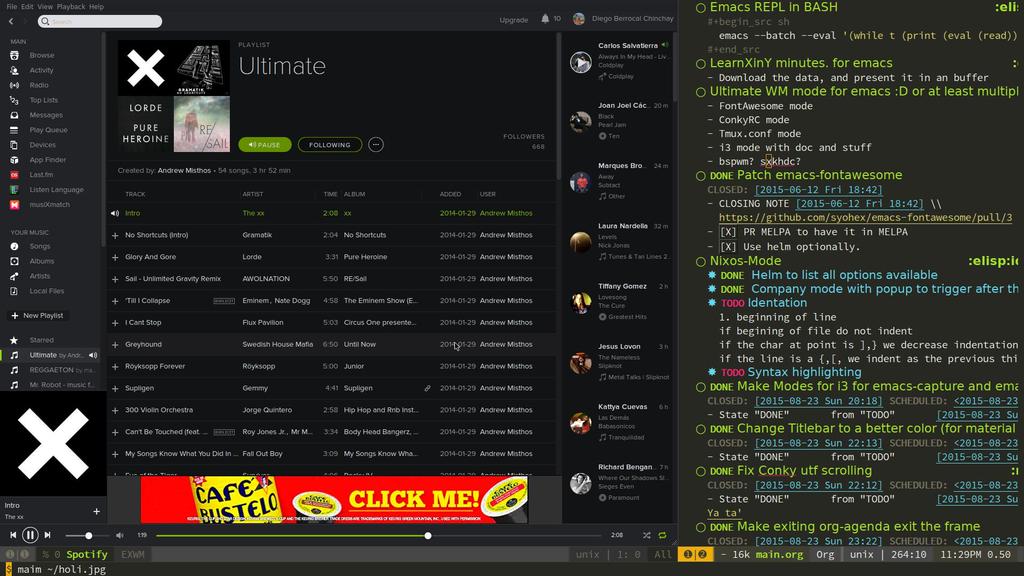4.6 KiB
EXWM layer

Description
The time has arrived when one can finally use Emacs as a Window Manager, long ago the concepts of windows and frames made so much sense when one was working in a TTY, and basically that's all the window management you got. In these modern times though, it sounds silly to have those names. But not Anymore!
Thanks to @ch11ng and his EXWM project we can now use Emacs as our window manager, and all those windows that didn't make sense before, now can not only hold buffers, but X Windows, that means that you can spawn a Browser Window, or your music player, or anything.
I urge you to read the EXWM Wiki for a more in depth explanation and if you can contribute, please do so! The purpose of me making this layer is that I find it awesome and having nice defaults would make more people dive into it and the project would receive more attention and contributions which will only make it more awesome, so if you try it and like it, share it!
Features:
- Support for using Spacemacs as window manager
Install
To use this configuration layer, add it to your ~/.spacemacs. You will need to
add exwm to the existing dotspacemacs-configuration-layers list in this
file.
Note about Display Managers
This is most common among Ubuntu and derivative users:
LightDM, GDM, and other Display managers that need a session file will need you
to copy the desktop file I bundled with this layer to
/usr/local/xsessions/exwm.desktop, that's what I used on my Ubuntu box, but
make sure the exwm-start script is in your PATH, you can put it in
/usr/local/bin/exwm-start and that should be enough, next time you log out,
select the EXWM session instead of the Ubuntu one and you should be alright.
Not having Display Managers
If you use Arch, Gentoo, or any other Linux, most probably you'll start your
configurations via a .xinitrc file, just append exwm-start to the end of
that file and you should be fine. I do recommend to check the EXWM Wiki for more
details.
OSX
If you are an OSX user, please report back on whether this works with xQuartz, always back up your data before attempting to try stuff like this.
Key bindings
As other window managers the s or Super key (Windows Key) is the one that
is the prefix to every action. We'll use a lot of s.
I have, for convenience, disabled the use of C-x and C-c in X windows,
mainly because that's something we could use for Cutting and Copying text, but if
you want you can enable it, this layer focuses on less Emacs-y bindings.
| Key Binding | Description |
|---|---|
C-q |
Send next key pressed to the X window |
C-' |
Pop shell |
C-g |
Universal GetMeOuttaHere Key from Emacs |
C-u |
Universal Argument |
C-[0-9] |
Universal Prefix for [0-9] |
M-m |
Spacemacs Leader Key |
s-[1 2 3 ... 8 9 0] |
Switch to workspace [1 2 3 … 8 9 10] |
s-TAB |
Switch to last workspace |
s-w |
Workspace Switch Menu (kinda like micro-state) |
s-r |
Reset window state |
s-SPC |
App Launcher |
s-ESC |
Lock Screen |
s-: and s-; |
Helm M-x (same as SCP :) |
s-u,U |
Undo, Redo window configurations |
s-b |
Show all opened buffers |
s-h,j,k,l |
Switch to left,lower,upper,right window |
s-H,J,K,L |
Move window to far left,down,lower,upper,right |
M-s-h,j,k,l |
Resizing (try them, it's too hard to explain) |
s-[,] |
Switch to prev,next workspace |